
 |
|||||
|
|
|||||
|
|
|
|||||
|
|
STANLEY PEARCE An unusual apple, probably a local variety, of uncertain age, brought to our notice by Rosemary and Anthony Hay, of Speen. The tree is not remarkably old and grows in the garden of the late Stanley Pearce (1929-2008) at Watchet Lane in Speen, Buckinghamshire. Local people still marvel at the beautifully painted traveller’s caravan in the garden. He was an interesting character, born in a remarkable, small, single floor flint cottage. It was owned for several generations by his family and he lived there all his life, initially with his grandparents and cousin. When 14, he left school and went to work for the War Agriculture programme. He was based at Amersham, where he drove tractors from Amersham to Bicester (nearly 30 miles). Cold, long and perilous work for a 14 year old in a slow, open vehicle. He then worked for the same engineering company until retirement. As a child gardening enthusiast, he had an allotment, and kept one throughout his life. We visited his garden shortly after his death and the cottage is now owned and has been sensitively renovated by his nephew Nobby Profit. The apple is small to medium sized, longish, quite ribbed and borne in profusion on quite a small tree. It appears to ripen over a period from mid-September and will store for a few weeks. It is a pleasant, crisp and juicy, sweet apple, but its primary use has been to make cider. The apples are brightly coloured with scarlet and dark red, over a green skin. Our thanks to Mr and Mrs Hay for their help. Pollination Group 5 |
|||
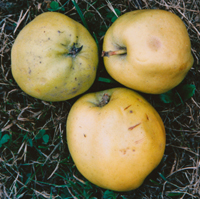 |
STIBBERT Stibbert, Summer Stibbert, and Stubbard have been made synonymous by Hogg and the National Apple Register. There is also a Michaelmas Stubbard recorded, which might be synonymous. Descriptions broadly agree that it is a medium sized, tall, conical apple, and with lemon yellow skin, more or less coloured with brown to bright crimson patches in the sun. Hogg calls it small and describes pronounced asymmetrical ribbing. The flesh is sweet, tender and mildly acid. It was a popular West Country apple, for dessert and culinary use. It is ripe in late August to September. If they are all the same then the earliest reference is Forsyth (1810). The version offered here is from Hilary Wilson, and is that of the National Collection. There is a different Stibbert still known in the west country which is heavily ribbed and might be that of Hogg. T* Pollination Group 3 |
|||
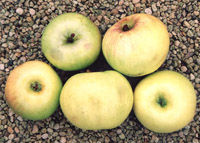 |
STIRLING
CASTLE Of uncertain origin but one account says it was raised
around 1820 by an amateur grower who kept a toyshop. Another says it had
long been grown by cottagers in the Stirling area before being distributed
by Drummond's Nursery. A large culinary apple with white, juicy flesh,
which cooks to a good purée with plenty of flavour. It has been
popular in the North of England and Scotland as it is very hardy. An Edwardian
favourite, the tree has pretty blossom. Fruit may be picked in mid September
and will keep until December, when grown in the north, but in the south
it is ripe in late August and does not keep so long. A very reliable cropper.
Pollination Group 3 |
|||
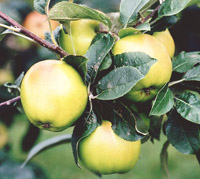 |
STOKE
EDITH PIPPIN First recorded in 1872 by Scott in ‘The Orchardist’,
as Stock-Edith Pippin. It is said to have originated at Stoke Edith in
Herefordshire. Hogg, in 1884, described it as a small fruit, tapering
pearmain-shaped with skin ripening to yellow, with an orange blush in
the sun, and patches of thin grey russet all over. ‘An excellent
dessert apple’. The flesh is yellow, crisp, juicy, sweet and fragrant.
It has been used for cooking and cider, as well as being a good dessert
apple. Ripe in October the apples will last until the year end. Pollination
Group 4 |
|||
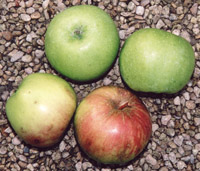 |
STONE
PIPPIN The name Stone Pippin was first mentioned by Worlidge
in 1678. Several references followed in the 18th century and after. There
are two distinct Stone Pippins recorded in the national apple register
of 1971 and it is also know to be a synonym of other apples. There is
also a Norfolk Stone Pippin and a Somerset Stone Pippin. They have become
confused and lost, though examples still exist in foreign collections.
We retrieved two, one from America and another from the Grove Farm Research
Station in Tasmania, in 2005. Both have fruited regularly and they are
the same. The apple is small to medium, flattened oblong, sometimes conical,
round, green turning very pale yellow with an orange blush and pronounced
pale dots. The stalk is medium sized, slender in an average cavity with
a knob near the stalk. The eye is small and closed in a slightly ribbed
shallow basin. The flesh is firm, not that juicy but with a strong, rich,
aromatic flavour. When cooked, the flesh keeps its shape and is very rich,
though wanting a little sugar added. Ripe in late October or November,
the apples will last in good condition well into the new year. It has
impressive blossom of pale pink. Pollination Group 4 |
|||
STOWE
RECUMBENT Around the year 1995, we walked around Stowe, Buckinghamshire
and saw a single fallen old apple tree, close to a hedge on open land.
Whether it was within Stowe Landscape Gardens and was just ignored when
the Gardens were laid out and all habitation cleared, in the mid 1700s,
we cannot say. If there was an old orchard there, the property it was
attached to had long disappeared. We took a cutting to graft a tree here.
This is a very good dual prupose apple and a quite attractive fruit, lavishly
washed and streaked with crimson and carmine. Ripe in mid October, it
is a fully rounded eating apple, with crisp, juicy enough, sweet and nicely
acidulated flesh of excellent flavour that lingers in the mouth. The flesh
moves from crisp to yielding in a week or two but remains good. When cooked,
it softens quickly and keeps its shape, though it would mash. It has now
developed a very rich and tangy flavour, sweet enough but on the edge
as to whether to add sugar. Very good indeed. Pollination Group 4 |
||||
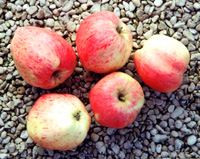 |
STRAWBERRY
QUEEN We recently returned to the large old orchard, attached
to the 17th century thatched house, which we had investigated many years
earlier with the late Mrs Story, at the oldest part of Little Ickford,
just in Buckinghamshire but very close to Oxfordshire. Mrs Story’s
daughters, Clare and Jo, met us there and we were able to offer some variety
names revealed by dna profiling. Three trees had unmatched dna and have
now been included in this catalogue. Ickford Russet and Thomas Tipping
are the others. Strawberry Queen was a very large and very old tree somewhat
overgrown and shaded by other trees, and the fruit was poor but, having
grafted all the trees years earlier, we were able to take fully formed
apples on our return visit and we all agreed the apples were of exceptional
interest. In late September the apples are sweet, but sometimes a little
sharp, crisp, but yielding, and juicy, with a distinct flavour of strawberries
and some other pleasant floral scent. They are a pleasure to eat raw but
are even better when cooked. They are initially resistant to cooking but
then soften quickly, keeping some shape but willing to mash. The flavour
is much changed. A little added sugar enhances the now very rich flavour
it has developed, though the strawberry scent has gone. This is an excellent
very old variety and was named Strawberry Queen, speedily that very day
we visited with some apples, by Clare, with speedy agreement by Jo. It
combines its nature with the old apple names such as queen, queening and
quoining etc. Pollination Group 5 |
|||
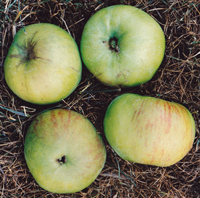 |
STRIPED
BEEFING Discovered in 1794 in the garden of William Crowe of
Norwich, but not widely grown until the mid nineteenth century. A late
culinary/dessert apple with large, striking fruit, of irregular shape
and with broad dark red stripes. Richly flavoured flesh, good for baked
apples and sweet enough to eat as a dessert apple by January. Stores until
May. Spreading trees. T*. Pollination Group 3 |
|||
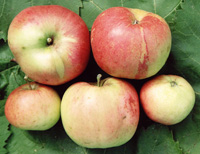 |
STUBBARD
The naming of several different apples, called Stubbard and Stibbert,
has become very confused. They appear to be West Country apples with a
long history. Philip Miller in 1739 referred to a Stubbard’s Apple
as ripe in July, while others have described such apples as ripe in autumn.
Different ones still exist, but they are not the same as the Stubbard
we found in the Grove Heritage Collection in Tasmania, where many a ‘lost’
English apple found its way and a new home. They kindly sent scion wood.
We have observed its fruiting for a few years now and it seems most likely
to be the old Michaelmas Stubbard. As the name suggests, the apples are
ripe at the end of September (sometimes later) and are medium to large,
with five obscure angles, russet at both ends and skin of pale green and
streaks of dark red, broken with russet. Apple are initially a little
sharp for dessert, but excellent for cooking when the flesh breaks down
well, but not all the way to a purée, though it would, if forced.
The flavour is fairly sharp and needs a little sugar but is very rich.
In November and December they soften a little and are not so sharp. By
January they are sweet enough to eat raw. The trees fruit when young and
bear abundantly. The buds are brightly coloured with pink and red, and
the tree has large open flowers of rosy pink. Trees are part tip bearing,
but spurring well. Pollination Group 2 |
|||
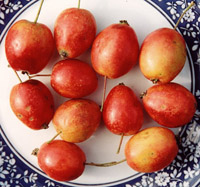 |
STUDLEY
CRAB A very interesting old crab apple, growing in the garden
of Mikael Zoghbi, which adjoins the gardens, in Studley, Oxfordshire,
where the two Beckley Red apples were found. It is very likely that the
three gardens were once part of an ancient orchard attached to the mediaeval
Studley Priory, which stood close by. It appears to be one of the ‘Siberian’
crabs, imported centuries ago and used in the development of the West
Country cider industry. These old varieties are no longer found domestically.
The oval to conical apples form in dangling clusters, and are barely an
inch wide, turning from yellow to warm amber and with a rich red flush
in the sun. In late September and October the apples become very sweet,
but with a certain amount of tannin that marks it out as ideal for cider.
It is a very ornamental tree when fruiting, and apples are very palatable
to eat, but too small to fill you up. Our thanks to Mr Zoghbi for several
interesting fruit trees, which he has allowed us to investigate. Pollination
Group 4 |
|||
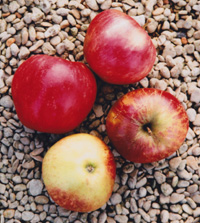 |
STUDLEY
GOLD Early in 2018, Linda Sankey, then living in the village
of Bremhill, Wiltshire, which was part of Lord Lansdown’s Bowood
estate, told us the fascinating story of Studley Gold. Studley is the
next village to Bremhill and was once also part of the Bowood estate.
Linda’s friend and neighbour, Dawn, had a ‘Studley Gold’
in her garden, now a mature and elegant freestanding tree. Dawn and Bob
Straker-Cook kindly sent wood for grafting and apples later in the year.
Dawn, having searched hard for a name for this apple had the good fortune
to spot a box of these same apples in a charity shop and, as Dawn relates
in an article for the local magazine, upon enquiring, the person in charge
said “Well, my dear, this variety is called Studley D’Or or
Studley Gold and was specially cultivated for the Bowood Estate. All the
cottagers on the Estate were given an apple tree, a plum tree and a pig.”
This was in the 19th century, and said to be the gift of an earlier Lord
Lansdown. Many of the cottages built in the 19th century have old apple
and plum trees in their gardens still, though the pigs have gone. There
are said to be other ‘Studley Golds’ in the neighbourhood.
The apples are ripe in early to mid October and are normally quite large,
some weighing over a pound. Though sweet enough to eat raw, fairly juicy,
with fine flesh and a good flavour, they are a little sour for a top quality
dessert apple and their real value is in the kitchen. When cooked the
flesh softens quickly, keeps its shape and is very rich, fruity and fragrant.
Just a little added sugar makes it perfect. Dawn reports that the crops
are usually very prolific and she enjoys drying slices and baking and
stewing the fruit. She also says that they do not keep particularly well,
though we kept the apples she sent to the start of December and they were
still good, even after a hot year in 2018. We are very grateful to Linda,
Dawn and Bob (and the person in the charity shop) for all their help in
revealing another important old variety. Perhaps, in time, the archives
of the Bowood Estate might reveal more. |
|||
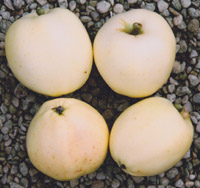 |
STUDLEY
SALAMANDER Around the year 2000, while investigating old orchard
trees at Studley (Horton cum Studley) near Oxford, we called in at Studley
Priory, the site of a Benedictine nunnery, dissolved in the times of Henry
VIII and rebuilt subsequently. We hoped to find more old fruit trees.
We found one, cut off at ground level, chopped up, doused in petrol and
oil and now only smouldering remains on a bonfire. The gardeners that
we spoke to explained that the priory had been sold and that their instructions
were to clear some old trees. Miraculously, there were a few twigs at
the bonfire’s edge which, although charred and reeking of petrol,
we could salvage in the hope of grafting a new tree. Against all odds,
it was a success. The new tree took many years to fruit, but 2015 revealed
quite a remarkable apple and one which it was easy to say was no longer
known, such was its individuality. It is a strangely pale apple. Though
others exist, they do not have the sharp nature of this culinary apple.
We have named it Salamander after the myths surrounding the reptile, which
had or could imbue the power to protect from fire or to survive fire.
The apples are ripe in late September, but will continue unchanged in
nature over the next two months. Firm and sharp. They do not mellow to
eating quality. Cooked, the flesh does not soften quickly and keeps its
shape well. The taste really develops and is very rich, tangy and fruity.
The addition of a little sugar is desirable. Excellent for pies. Pollination
Group 4 |
|||
|
||||